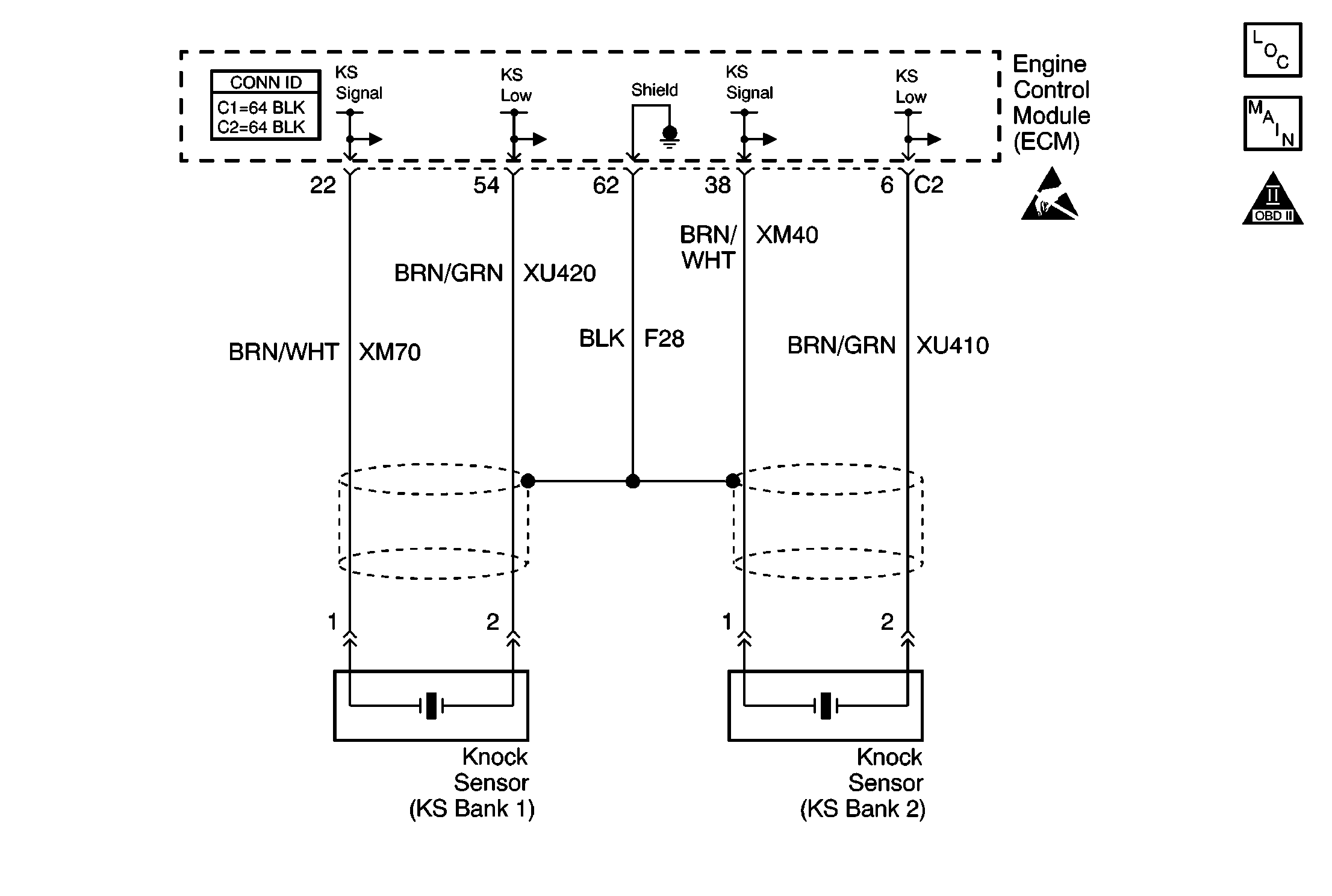
Circuit Description
The knock sensor (KS) system is used in order to detect any engine detonation. The engine control module (ECM) will retard the spark timing based on the signals from the KS module. The knock sensors produce an AC voltage that is sent to the KS module. The amount of AC voltage produced is proportional to the amount of knock.
An operating engine produces a normal amount of engine mechanical vibration, noise. The knock sensors will produce an AC voltage signal from this noise. When an engine is operating, the ECM will learn the minimum and maximum frequency of the noise the engine produces. When the ECM determines that this frequency is less than or more than the expected amount, a knock sensor diagnostic trouble code (DTC) will set.
Conditions for Running the DTC
| • | The ECT is more than 40°C (104°F). |
| • | The engine has idled for 5 seconds allowing the ECM to learn a minimum engine noise level. |
| • | Engine has been running at least 10 seconds. |
| • | The engine speed is more than 2,000 RPM. |
Conditions for Setting the DTC
The ECM does not detect a difference between the minimum learned engine noise level at idle and the engine noise between 2500-3500 RPM for 5 seconds.
Action Taken When the DTC Sets
The ECM will not illuminate the malfunction indicator lamp (MIL).
Conditions for Clearing the MIL/DTC
| • | The DTC clears after forty consecutive warm-up cycles if no failures report by this diagnostic or any other non-emission related diagnostic. |
| • | The scan tool clears the MIL/DTC. |
Diagnostic Aids
Notice: Using the J 35616-A Connector Test Adapter Kit will prevent damage to the harness connector terminals.
Use the J 35616 Connector Test Adapter Kit for any test that requires probing the ECM harness connector or a component harness connector.
Check for the following conditions:
| • | The knock sensor for proper installation. A knock sensor that is loose or over torqued may cause this DTC to set. |
| • | The KS shield wiring for continuity. Insert a test lamp connected to B+ carefully between the KS wiring outer insulation and the inner wires. Good KS shield continuity will illuminate the test lamp. |
| • | Poor connections at the ECM or at the component--Inspect the harness connectors for any backed out terminals, improper mating, broken locks, improperly formed or damaged terminals, and poor terminal to wire connection. Refer to Engine Control Module Diagnosis , Checking Terminal Contact for the proper procedure. |
| • | Misrouted harness--Inspect the harness in order to ensure that the harness is not routed too close to any high voltage wires such as spark plug leads, or too close to any high current devices such as the alternator, the motors, the solenoids, etc. |
| • | Damaged harness--Inspect the wiring harness for any damage. If the harness appears to be OK, observe the scan tool while moving the related connectors and the wiring harnesses. A change in the display may help in order to locate the fault. |
| If the sensor signal is only affected when the harness is moved at a component, and there is no problem with the harness or connections, the component may be damaged. |
Refer to Symptoms for the Intermittents.
Test Description
The numbers below refer to the step numbers on the diagnostic table.
Step | Action | Values | Yes | No |
|---|---|---|---|---|
1 | Did you perform the Powertrain On-Board Diagnostic (OBD) System check? | -- | Go to Step 2 | |
|
Important: If an engine knock can be heard, repair the engine mechanical problem before proceeding with this diagnostic.
Is this DTC set? | -- | Go to Step 3 | Go to Diagnostic Aids | |
3 |
Is the voltage measured on both circuits greater than the value specified? | 10 V | Go to Step 4 | Go to Step 7 |
4 |
Is the resistance measured on any test less than the value specified? | 2 ohms | Go to Step 8 | Go to Step 5 |
5 |
Did you find and correct a problem? | -- | Go to Step 10 | Go to Step 6 |
6 |
Did this DTC pass? | -- | Go to Step 11 | Go to Step 9 |
7 | Repair the open or high resistance in the circuit that did not indicate voltage higher than the specified value. Is the action complete? | 10 V | Go to Step 10 | -- |
8 | Repair the circuit that is shorted to ground or repair the KS signal and low circuits shorted together. Is the action complete? | -- | Go to Step 10 | -- |
9 |
IMPORTANT: This vehicle is equipped with a Theft Deterrent System which interfaces with the Engine Control Module (ECM). Program the new ECM with the frequency code of the theft deterrent module that is currently on the vehicle. Replace the ECM. Refer to Engine Control Module Replacement/Programming . Is the action complete? | -- | Go to Step 10 | -- |
10 |
Does the scan tool indicate that the diagnostic Passed? | -- | Go to Step 11 | Go to Step 2 |
11 | Does the scan tool display any additional undiagnosed DTCs? | -- | Go to the applicable DTC table | System OK |
